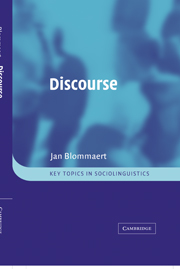Book contents
- Frontmatter
- Contents
- Preface
- Acknowledgments
- 1 Introduction
- 2 Critical Discourse Analysis
- 3 Text and context
- 4 Language and inequality
- 5 Choice and determination
- 6 History and process
- 7 Ideology
- 8 Identity
- 9 Conclusion: Discourse and the social sciences
- Notes
- Appendix: English translations of the documents in chapter 5
- Glossary
- References
- Index
4 - Language and inequality
Published online by Cambridge University Press: 02 December 2009
- Frontmatter
- Contents
- Preface
- Acknowledgments
- 1 Introduction
- 2 Critical Discourse Analysis
- 3 Text and context
- 4 Language and inequality
- 5 Choice and determination
- 6 History and process
- 7 Ideology
- 8 Identity
- 9 Conclusion: Discourse and the social sciences
- Notes
- Appendix: English translations of the documents in chapter 5
- Glossary
- References
- Index
Summary
The problem: voice and mobility
I announced in the introductory chapter that this book would address power effects in the field of language in society, and that, more in particular, inequality would be my central concern. Furthermore, I said that issues of voice would be identified as crucial in explaining inequality. I also defined voice (following Hymes 1996) in general as the ways in which people manage to make themselves understood or fail to do so. This capacity to make oneself understood, I argued, is a capacity to generate an uptake of one's words as close as possible to one's desired contextualisation. It is, in other words, the capacity to accomplish desired functions through language. More accurately, it is the capacity to create favourable conditions for a desired uptake: if I want to formulate a polite request, I shall attempt to make my words come across as a polite request and not as a rude command; if I want to declare my love to someone, I shall try to make sure that the object of my love understands it that way. In each case I shall mobilise what I believe are the most (denotationally) adequate, contextually appropriate, semiotic means to do so, hoping that the interlocutor will follow my directions of contextualisation.
But such a capacity is not self-evident, I stressed in chapter 5, for this capacity – while essentially creative – is subject to several conditions and constraints.
- Type
- Chapter
- Information
- DiscourseA Critical Introduction, pp. 68 - 97Publisher: Cambridge University PressPrint publication year: 2005
- 2
- Cited by



